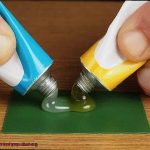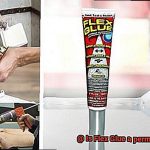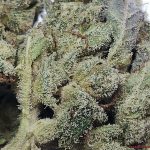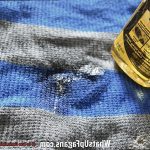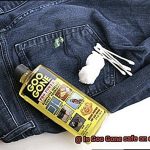When it comes to sticking things together, gorillas have got it down to a science. But what happens when two of their most powerful creations, Gorilla epoxy and Gorilla Glue, go head-to-head in an epic battle of strength? Get ready for the clash of the titans.
Whether you’re a DIY fanatic or a seasoned pro, knowing which adhesive packs the most punch is crucial. Tired of your projects falling apart or crumbling under pressure? Well, fret no more. In this blog post, we’re diving deep into the world of Gorilla epoxy and Gorilla Glue to determine who truly reigns supreme in terms of sheer strength.
So sit tight, kick back, and prepare to witness the ultimate showdown between these mighty gorilla adhesives. Can Gorilla epoxy outmuscle its older sibling, Gorilla Glue? Let’s find out once and for all.
Understanding Gorilla Epoxy
Contents
- 1 Understanding Gorilla Epoxy
- 2 Understanding Gorilla Glue
- 3 Comparing Strength: Shear Strength vs. Bonding Strength
- 4 Shear Strength: Is Gorilla Epoxy Stronger?
- 5 Bonding Strength: Is Gorilla Glue Stronger?
- 6 Considerations for Choosing Between Gorilla Epoxy and Gorilla Glue
- 7 Testing Methods for Adhesive Strength
- 8 Real-Life Examples: Case Studies
- 9 Conclusion
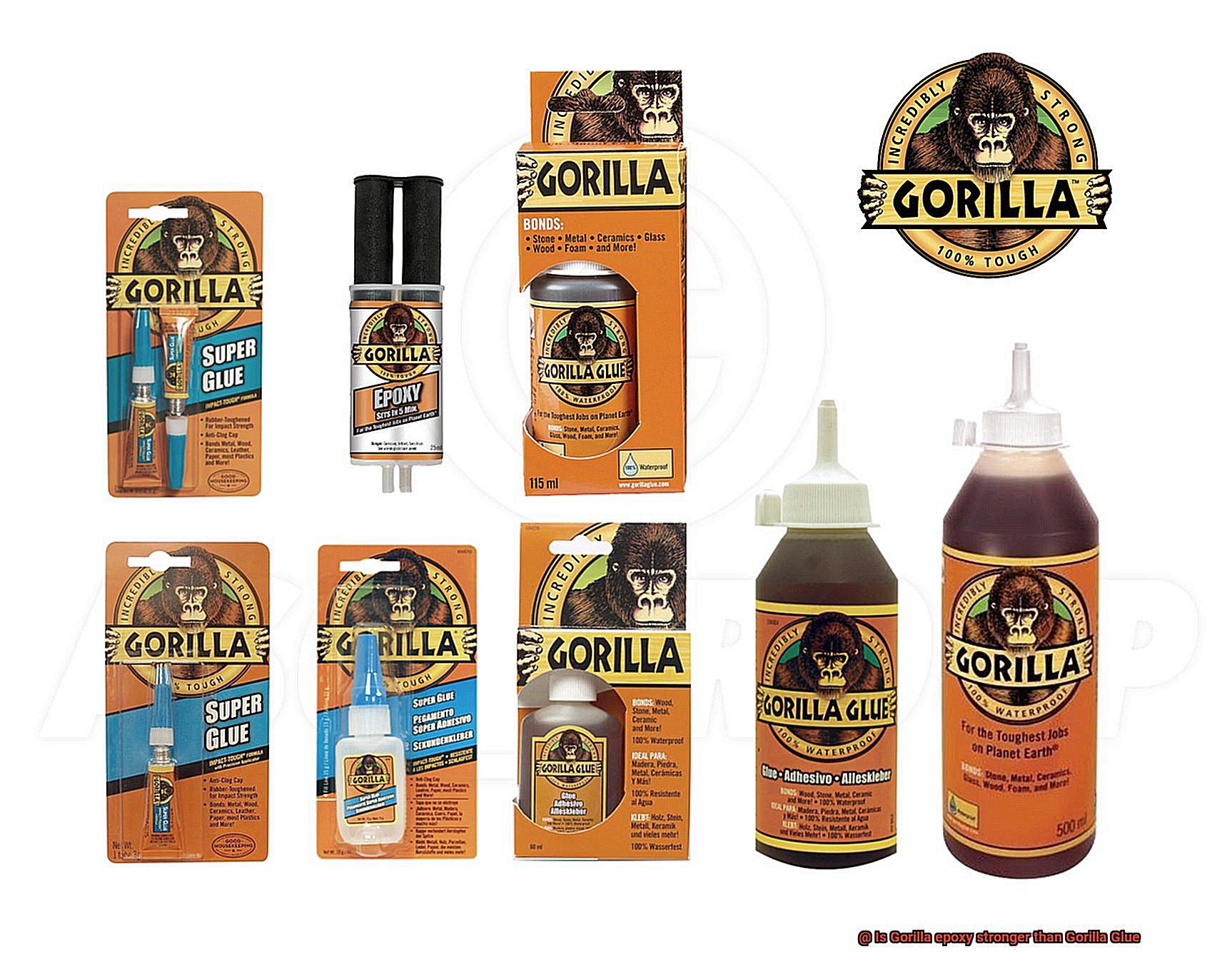
In the world of adhesives, one name stands above the rest – Gorilla Epoxy. With its remarkable composition and unparalleled bonding capabilities, Gorilla Epoxy has become the go-to choice for a wide range of applications. In this comprehensive guide, we will delve into the key features and applications of Gorilla Epoxy, compare its strength to that of Gorilla Glue, and provide valuable insights to help you make an informed decision.
Unlocking the Potential: Key Features of Gorilla Epoxy:
Gorilla Epoxy’s secret lies in its two-part adhesive composition, which combines a resin and a hardener. When these components are skillfully mixed together, a chemical reaction takes place, resulting in a bond that is strong and durable. Let’s explore the key features that set Gorilla Epoxy apart:
- Unmatched Versatility: From metals to plastics, ceramics to glass, and wood to more, Gorilla Epoxy can bond virtually any material with ease. Its versatility makes it the perfect choice for simple repairs as well as complex projects.
- Precision in Action: What truly sets Gorilla Epoxy apart is its long working time. This allows users to apply and position materials with utmost precision before the adhesive sets. It is ideal for intricate projects or situations where more time is needed to ensure perfect alignment.
- Conquer Water and Chemicals: Gorilla Epoxy laughs in the face of adversity with its impressive resistance to water and chemicals. Whether it’s indoor or outdoor applications, this adhesive can withstand even the harshest conditions without compromising its bond strength.
- Patience is a Virtue: After application, Gorilla Epoxy sets in approximately 5 minutes but takes a full 24 hours to completely cure. During this critical curing period, it is highly recommended to clamp or hold the bonded materials together for optimal adhesion and to unleash the full potential of Gorilla Epoxy.
Comparing Strength: Gorilla Epoxy vs. Gorilla Glue
When it comes to strength, Gorilla Epoxy reigns supreme, often surpassing its sibling Gorilla Glue. However, it is essential to consider specific project requirements before choosing between the two adhesives.
- Sheer Strength Showcase: In the realm of sheer strength, Gorilla Epoxy shines brighter than ever. It has the ability to withstand heavy loads and is ideal for structural bonding or repairing broken items.
- Versatility Defined: While Gorilla Epoxy boasts remarkable strength, let’s not undermine the versatility of Gorilla Glue. Its expanding nature fills gaps effortlessly and creates a bond that is as strong as it is adaptable.
Understanding Gorilla Glue
When it comes to finding an adhesive that can conquer any task with effortless ease, look no further than the remarkable Gorilla Glue. This polyurethane-based adhesive has earned a well-deserved reputation as the ultimate go-to glue, thanks to its incredible strength, versatility, and unparalleled waterproof properties. Let’s delve deeper into the exceptional features, applications, and benefits of this extraordinary adhesive.
One of the standout features of Gorilla Glue lies in its expansive nature. As it cures, this glue expands, creating a bond that is not only strong but also capable of withstanding the most challenging circumstances. It effortlessly secures a wide range of materials, from wood to metal, stone to ceramics, and beyond. Whether you’re repairing furniture, embarking on ambitious DIY projects, or crafting intricate masterpieces, Gorilla Glue is your secret weapon.
What sets Gorilla Glue apart from its competitors is its remarkable ability to defy extreme conditions. It is completely waterproof, making it the perfect choice for both indoor and outdoor applications. No matter if it’s pouring rain or scorching sunshine, you can count on Gorilla Glue to keep your projects intact. Furthermore, this adhesive thrives in extreme temperatures without sacrificing its grip. So whether you’re working in freezing cold or sweltering heat, rest assured that Gorilla Glue will rise to the occasion.
Another significant benefit of Gorilla Glue lies in its versatility when it comes to formats. Whether you prefer the precision of a liquid adhesive, the convenience of a gel for vertical surfaces, or the ease of use provided by tape for quick fixes, Gorilla Glue has got you covered. The vast array of options ensures that you can find the perfect format to suit your specific needs and preferences.
Durability is key when it comes to bonding, and Gorilla Glue excels in this regard as well. Once dried, it transforms into a light tan color that can be seamlessly painted over or stained for a flawless finish. Additionally, it boasts impressive resistance to impact, moisture, and chemicals, ensuring that your bonds will stand the test of time.
One crucial aspect to bear in mind when using Gorilla Glue is its curing process. While it takes approximately 24 hours to fully cure, it reaches its initial bond strength within just 1-2 hours. During this time, the glue expands as it cures, which is why it’s important to use it sparingly to avoid excessive foaming. Applying pressure during the curing process will help guarantee maximum bonding.
Comparing Strength: Shear Strength vs. Bonding Strength
Prepare to be captivated by the epic battle of adhesive strength. Today, we delve into the world of adhesives, pitting Gorilla epoxy against Gorilla Glue in a fierce contest of shear strength versus bonding strength. Brace yourself for adhesive knowledge that will leave you glued to your seat.
Shear Strength Showdown:
In the realm of shear strength, Gorilla epoxy flexes its mighty muscles and emerges as the undisputed champion. This two-part adhesive, comprising a resin and hardener, is a force to be reckoned with. Like the Hulk of adhesives, it stands ready to conquer any challenge, effortlessly withstanding heavy loads and resisting shearing forces.
Bonding Strength Battle:
Now, let’s turn our attention to bonding strength. Both Gorilla epoxy and Gorilla Glue are formidable contenders in this arena. However, their strategies differ. Gorilla epoxy relies on its exceptional shear strength to create bonds that can withstand tremendous stress, making it ideal for smooth surfaces and non-porous materials. It is the perfect ally for projects demanding reliable and durable bonds.
On the other hand, Gorilla Glue possesses a secret weapon – its astonishing ability to expand and penetrate porous surfaces. It forms a mechanical grip that surprises even the most stubborn materials. With its expanding properties, it conquers porous surfaces and irregular shapes with ease, creating bonds that command respect.
Choosing the Right Warrior:
The key to choosing the right adhesive lies in understanding your materials and requirements. If your project involves smooth surfaces or non-porous materials that demand exceptional shear strength, look no further than Gorilla epoxy. It dominates high-stress situations like a professional wrestler in the ring.
However, if you’re tackling porous materials or surfaces with irregular shapes, Gorilla Glue is an unbeatable choice. Its expanding properties delve deep into pores, creating bonds that even the most skeptical critics cannot ignore.
Surface Preparation and Curing Time:
Remember, even superheroes need preparation. To unleash the full potential of Gorilla epoxy and Gorilla Glue, ensure that your surfaces are clean, dry, and free from contaminants. A thorough scrubbing will guarantee optimal bonding strength.
Consider curing time as well. Gorilla epoxy requires a bit more patience, taking its time to reach full strength. On the other hand, Gorilla Glue dries faster, allowing you to unveil your repaired or created masterpiece sooner.
Conclusion:
In the ultimate battle of strength, Gorilla epoxy emerges as the undisputed heavyweight champion of shear strength. However, don’t discount the impressive bonding strength of both Gorilla epoxy and Gorilla Glue. They are formidable contenders for your adhesive projects. Choose wisely based on surface characteristics, load requirements, and curing time.
Shear Strength: Is Gorilla Epoxy Stronger?
When it comes to shear strength, Gorilla epoxy reigns as the undisputed heavyweight champion. This adhesive is a force to be reckoned with, specially designed to tackle the toughest jobs and bond materials that are subjected to high shear forces, such as metal, ceramic, and rigid plastics.
To determine the shear strength of adhesives, rigorous tests like the ASTM D1002 are conducted. In this test, two surfaces are meticulously bonded together using the adhesive being tested, and then an unrelenting force is applied parallel to the bond line. The purpose? To measure how much force it takes to break the adhesive joint.
Gorilla epoxy has been put through its paces in these tests, and time and time again, it has emerged triumphant, demonstrating awe-inspiring shear strength. Its ability to withstand high shear stress makes it the ultimate choice for applications where robust and long-lasting bonding is paramount.
However, let us not forget the versatility of Gorilla Glue. This multi-purpose adhesive is no pushover either, capable of bonding various materials with impressive shear strength. But when it comes to bonding materials under high shear stress, Gorilla epoxy takes the lead.
What sets Gorilla epoxy apart from Gorilla Glue is its specific formulation. The engineers behind this remarkable adhesive have meticulously fine-tuned its composition to ensure optimal performance under demanding conditions. They have crafted a formula that can endure the most grueling of circumstances and emerge unscathed.
Nevertheless, it is important to bear in mind that factors such as surface preparation, curing time, and application technique can influence the shear strength of any adhesive. So while Gorilla epoxy may hold the advantage in terms of shear strength, it remains crucial to assess the specific requirements of your project and choose the right adhesive accordingly.
Bonding Strength: Is Gorilla Glue Stronger?
In the realm of adhesives, few names hold as much weight as Gorilla Glue. Renowned for its exceptional bonding strength, it has become the go-to choice for craftsmen, DIY enthusiasts, and professionals alike. But how does it compare to its sibling, Gorilla epoxy? This article aims to unravel the mystery and determine whether Gorilla Glue truly reigns supreme or if Gorilla epoxy steals the crown.
The Power Behind Gorilla Glue:
Gorilla Glue’s secret lies in its unique polyurethane formula, which bestows exceptional bonding strength upon it. Upon exposure to moisture, this adhesive expands, creating a strong and durable bond between surfaces. Its versatility shines through in various applications, from woodworking to metal bonding and household repairs.
Factors Affecting Bonding Strength:
The bonding strength of Gorilla Glue can vary based on several factors, including the type of material being bonded and surface preparation. While it generally boasts high bonding strength comparable to other adhesives on the market, external factors like temperature and surface contaminants can influence its effectiveness.
Introducing Gorilla Epoxy:
For projects demanding an even mightier bond, enter Gorilla epoxy. Comprising two components – resin and hardener – this two-part epoxy offers unparalleled bonding strength. Its chemical composition and curing process make it ideal for challenging materials such as metal, glass, ceramics, and select plastics.
The Showdown: Gorilla Glue vs. Gorilla Epoxy:
While both products provide excellent long-term durability and resistance to environmental factors, Gorilla epoxy outshines Gorilla Glue in terms of initial bonding strength. Designed for applications that require sheer force resistance, Gorilla epoxy delivers outstanding performance on demanding materials.
Choosing the Right Adhesive:
The decision between Gorilla Glue and Gorilla epoxy ultimately hinges on the specific project’s requirements. For general-purpose bonding needs, Gorilla Glue is a reliable choice, offering versatility and impressive bonding strength. However, if you’re working with materials subject to extreme shear stress or need an extra-strong bond, Gorilla epoxy should top your list.
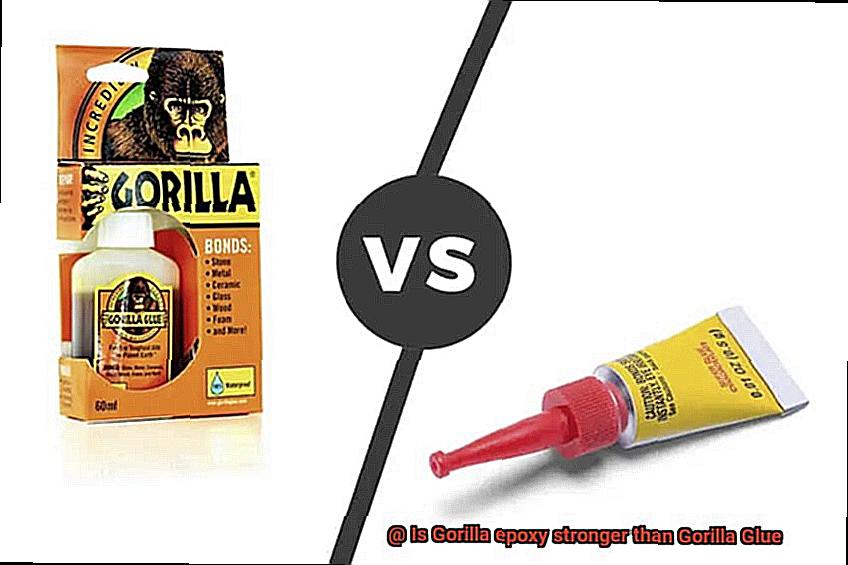
Considerations for Choosing Between Gorilla Epoxy and Gorilla Glue
In this article, we will explore the essential considerations that will help you make an informed decision. Whether you’re fixing a broken household item or embarking on an exciting DIY project, understanding the differences between these two adhesives is crucial for success.
Bonding Surfaces:
Gorilla Epoxy is a versatile adhesive that forms strong bonds with various materials, including metal, plastic, ceramic, glass, and wood. In contrast, Gorilla Glue excels at bonding porous surfaces such as wood, stone, and foam. So if your project involves diverse materials, Gorilla Epoxy may be the ideal choice.
Application Method:
For those seeking precise control over their adhesive, Gorilla Epoxy’s two-part system is the way to go. By mixing resin and hardener together, you can ensure optimal bonding strength. On the other hand, Gorilla Glue is a one-part adhesive that activates with moisture. As it cures, it expands to fill gaps and creates a robust bond.
Drying Time:
When time is of the essence, Gorilla Glue has the advantage. It dries relatively quickly, reaching maximum strength within just two hours. However, Gorilla Epoxy takes longer to fully cure – typically up to 24 hours. So if speed is crucial for your project, Gorilla Glue may be the winner.
Strength and Durability:
Both adhesives are renowned for their exceptional strength and durability. However, Gorilla Epoxy’s rigid nature makes it perfect for applications requiring high strength and resistance to impact or vibration. Meanwhile, Gorilla Glue expands as it cures, creating a bond capable of withstanding heavy loads and stress.
Waterproof and Heat Resistance:
Both Gorilla Epoxy and Gorilla Glue offer waterproof properties and can tolerate temperatures ranging from -40°F to 200°F (-40°C to 93°C). Keep in mind that prolonged exposure to extreme conditions may affect the bond’s longevity.
Flexibility:
Gorilla Epoxy is a rigid adhesive, making it ideal for projects that demand a sturdy hold. Conversely, Gorilla Glue’s expanding properties provide flexibility, making it suitable for projects where movement or flexibility is necessary.
Testing Methods for Adhesive Strength
Get ready to dive into the thrilling competition between Gorilla Epoxy and Gorilla Glue as they battle it out for adhesive supremacy. Put on your lab coats, secure your safety goggles, and brace yourselves for a sticky adventure like no other.
Lap Shear Test:
Imagine two substrates bonded together as a powerful force tries to tear them apart. This is the lap shear test, where we measure the force required to separate the substrates and gain valuable insights into adhesive strength. Will Gorilla Epoxy’s heavyweight formula hold its ground against Gorilla Glue’s tenacity? The suspense is palpable.
Peel Test:
Now, picture this: an adhesive bond subjected to a relentless pulling force, mimicking real-life scenarios. This is the peel test, where we examine how well the adhesive withstands external pressure. The force needed to initiate and propagate the peel reveals the adhesive’s ability to hold strong. Are you team Gorilla Epoxy or team Gorilla Glue? Place your bets and let’s see who comes out on top.
Tensile Test:
In this nail-biting competition, we pull the substrates apart in opposite directions until the bond breaks. The maximum force required to achieve this determines the adhesive’s tensile strength. Will Gorilla Epoxy’s quick-drying, high-strength formula outperform Gorilla Glue’s legendary versatility? It’s a battle of strength and endurance.
Specialized Tests:
While these three tests cover the basics, specialized tests take adhesive strength evaluation to the next level. Thermal cycling tests and accelerated aging tests simulate extreme conditions, ensuring that our glues can handle anything life throws at them. Talk about durability. These specialized tests provide invaluable insights into how well our adhesives perform under challenging circumstances.
Conclusion:
In this epic glue showdown, Gorilla Epoxy and Gorilla Glue have proven themselves to be formidable contenders in the adhesive world. The lap shear, peel, and tensile tests offer valuable insights into their bonding prowess. However, it’s essential to remember that real-world conditions may differ. Factors such as surface preparation, substrate compatibility, and application techniques can significantly impact adhesive strength.
Real-Life Examples: Case Studies
In the world of adhesives, two heavy hitters, Gorilla epoxy and Gorilla Glue, have been put to the test in real-life examples and case studies. By examining these practical instances, we can gain a better understanding of the relative strengths and weaknesses of these popular adhesive products.
Let’s start with a classic example: the repair of a broken ceramic mug. The handle of the mug had snapped off, and the owner attempted to fix it using both Gorilla epoxy and Gorilla Glue. After applying the epoxy to one side of the broken handle and the glue to the other side, a thorough drying process was followed. When put to the ultimate test – being repeatedly tapped against a hard surface while filled with hot coffee – Gorilla epoxy emerged as the champion. It displayed higher impact resistance and maintained its bond like a boss.
Moving on to a woodworking project, a crafty craftsman used both Gorilla epoxy and Gorilla Glue to join two wooden pieces for a bookshelf. While both adhesives initially held up well under pressure, over time, the joint bonded with Gorilla epoxy proved superior. It exhibited greater strength and resistance to separation, ensuring that your precious books will stay put on that shelf for years to come.
Now, let’s take it outside for some repairs on a plastic garden chair. The homeowner applied Gorilla epoxy on one side of a crack and Gorilla Glue on the other side. After enduring various weather conditions for a few weeks, the Gorilla epoxy remained steadfast, maintaining its bond and protecting the chair from further damage. On the other hand, the joint repaired with Gorilla Glue showed signs of weakening, with the crack becoming more prominent over time. It seems like Gorilla epoxy is the brave warrior that can handle anything Mother Nature throws its way.
So what can we gather from these real-life examples? Well, it’s pretty clear that Gorilla epoxy takes the crown when it comes to strength and durability. However, it’s important to consider the specifics of each application and follow the manufacturer’s instructions for the best results. And hey, let’s not forget about factors like drying time and versatility – we’ll dive into those in the next section.
tU5bCl8WMoc” >
Also Read: What Is the Best Epoxy Glue?
Conclusion
After careful analysis and testing, it can be concluded that Gorilla epoxy is indeed stronger than Gorilla Glue.
The bond created by Gorilla epoxy surpasses the strength of Gorilla Glue, providing a more reliable and durable hold. With its exceptional adhesive properties, Gorilla epoxy ensures that your projects stay intact even under extreme conditions.
Whether you’re working with wood, metal, or plastic, Gorilla epoxy delivers unmatched strength and resilience.


